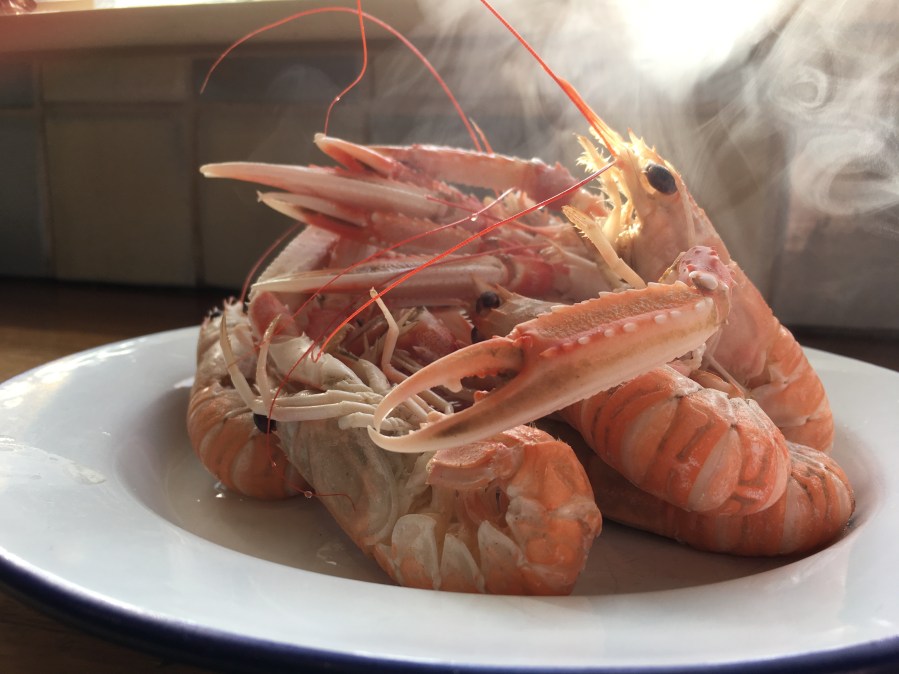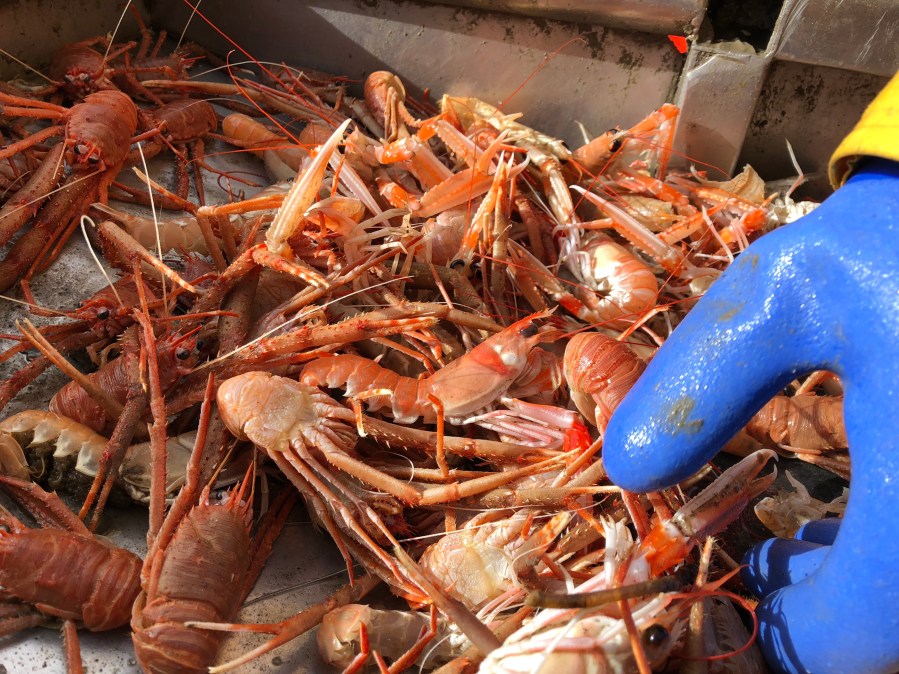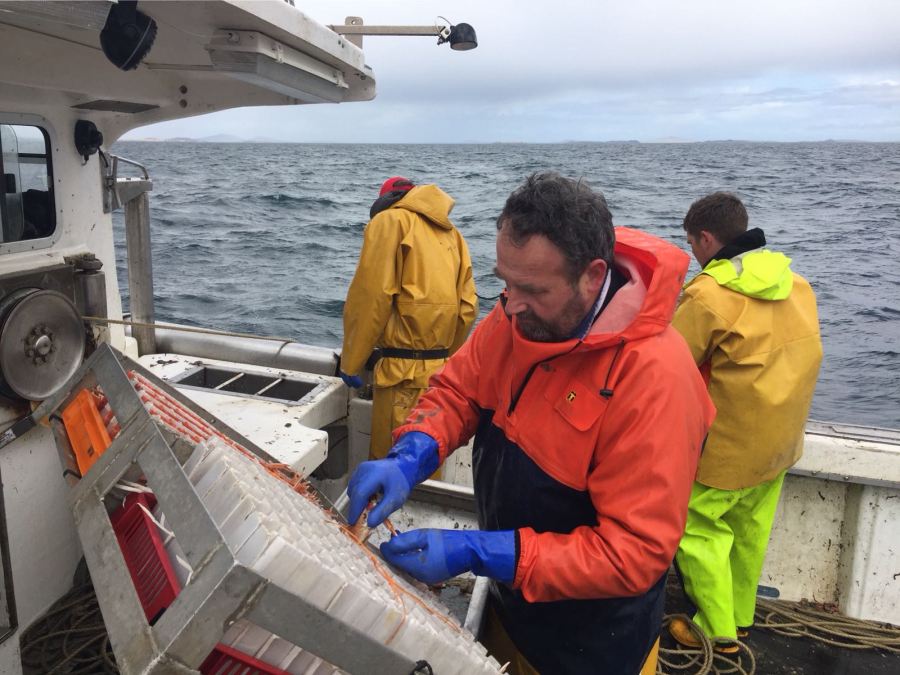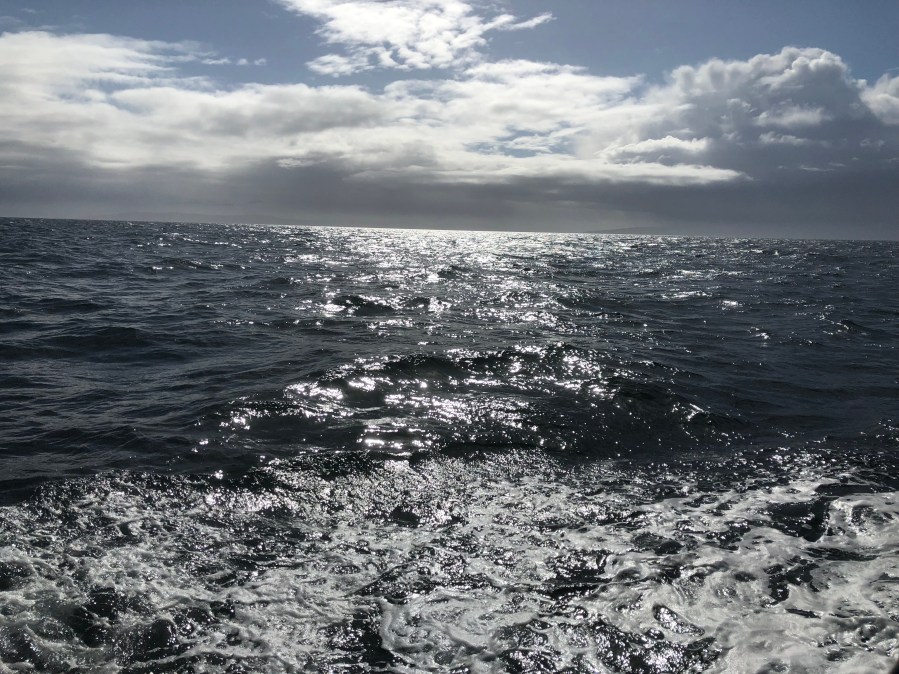Ever since I first visited the Scottish ‘prawn’ trawl fishery in Peterhead, I’ve been fascinated by langoustines. How can such an iconic, home-caught and sustainable shellfish species, be surrendered so readily to our export markets? Such flavour, such provenance and such nutrition. Yet another shining example of a fish that is embraced so feverishly by so many of our nearest continental cousins and one that we consume with reverence when on holiday abroad, but spurn in favour of imported crustacea when we return home, save for an appetite for breaded scampi.

Of course it’s all down to price, coupled with an astonishing lack of seafood culture for an island nation. Overall, we hold so little store in the plethora of seafood species that we harvest around our shores, preferring instead, to consume cheaper imported alternatives, the provenance of which is far harder to ascertain. In the project that I’m running for the Shellfish Association of Great Britain, we’re striving to redress this balance through the concerted promotion and understanding of British shellfish via both wild capture and aquaculture. It’s a mammoth task. However, by taking small, but effective, steps and cascading knowledge and and accurately reported information throughout the supply chain, small increments in the improvement of consumer perception can be achieved. I call it ‘traction’ and with an army of producers, processors, chefs, retailers, celebrities, and foodies behind me, stories like this are far easier to relay and to an increasingly wider audience.

This post is based on an article I wrote earlier this year for Country Life Magazine and tells the story of a trip to the Isle of Harris in the Outer Hebrides, that I made, to sample the langoustine in its finest form and condition. Live, creel-caught, from the pristine waters of the Minch and a product that attracts a considerable premium in restaurants across the country, unfortunately rendering it unaffordable for most.
Call them what you will, Langoustine, Dublin Bay Prawn, Norway Lobster or just plain Scampi, Nephrops norvegicus is to many a seafood-obsessive culture, about as good as it gets when it comes to quality shellfish.
A delicate and exquisitely flavoured crustacean, it epitomises everything that a well-structured Fruits de Mer should represent, and rightly so, for as its provenance attests, it is the stuff of countless coastal dishes, the mainstay of deliciously chargrilled harbour side platters, the adornment of steaming pans of paella and zarzuela, gilded in lemon butter or simply served raw, with coriander, lime and a lick of olive oil; enough to enliven the tastebuds of the most hardened of connoisseurs.

So why don’t we see them gracing our UK menus more often? Why, when the rest of the natural seafood-loving-world are vying for our production, don’t we embrace it ourselves, as a national treasure, rather than a cursory coating in crumbs and consigning to a deep fat fryer.
The deep, aquamarine tide-harried, waters of ‘The Minch,’ that lonely strait of water of separating the Scottish Highlands and Inner Hebridean Isles from their outlying neighbours of North Uist, Lewis and Harris, has traditionally played host to some of the finest examples of this spectacularly underrated species, with creel fishing and bottom-trawling both playing a large part in its harvest.

Shellfishing has been a mainstay of these wild, gale-lashed and lonely isles for centuries. Indeed the words ‘creel’ and ‘croft’ remain synonymous with the methods of food production here, with the harsh realities of island life, forcing many inhabitants to take to both sea and land historically, in search of sustenance.

Although langoustine, native lobster and brown crab predominate in terms of landings, the spectacular variety of other shellfish species seen here in abundance, (scallop, squat lobster, velvet crab, razor clam) are typical of a coastline served royally by a smorgasbord of planktonic life, powered by the omnipresent Gulf Stream, enlivening the waters in a rich soup of nutrition.

Langoustine, (prawns to the local fishermen) are one of those species that now demand the combined effort of both trawlers and potters, whose daily landings find their way into a ready and waiting convoy of refrigerated transport bound for the likes of Vigo and Santander and with 80% of UK production destined for that market, it’s small wonder that many of these little orange lobsters don’t actually make contact with British soil.
Donald MacLennan, Skipper of Valhalla (SY549) a fast, modern potting vessel, operating out of the tiny, but strategically important port of Leverburgh on the Sound of South Harris, is one of a generation of hardy Hebridean fishermen, who have embraced the opportunity afforded by the rich pickings that these waters yield.

Working with regular local crewmen Lewis and Ian Angus, they fish the waters of the Minch year-round, often in appalling weather, to ensure that a steady supply of lobster, crab and ‘langos’ reach the diners of Madrid and Barcelona.

The species inhabit markedly different ground and whereas the weather-limiting seas to the West, with their heaving Atlantic swells, are home to the blue-black native lobster populations and vast crawling cohorts of crab, the relatively sheltered waters of the Minch yield the orange gold, with Valhalla operating 1500 locally-made prawn creels in ‘fleets’ or strings of 90 pots each, marked with a buoy at either end.
‘We can usually fish the Minch in most weather,’ affirms MacLennan. ‘The lee of the islands means that sea conditions aren’t usually as harsh as we get further to the West’
The ‘langos’ are caught virtually all year round but are in prime condition from March right through the summer and with current prices buoyant, the fishermen are keen to maximise their landings.

I join the Valhalla and their crew for a day ‘on the prawns’ to see for myself just how sustainable this fishery is and how with Brexit on the horizon, the UK consumer could usefully benefit from such a ready supply of delicious home-grown and fully traceable wild protein.
Hauling the gear is an efficient and semi-automated task with each string of pots being hydraulically heaved to the surface, before being swiftly emptied onto a sorting table and re-baited with salted herring.
The crew work fast and with a metronomic rhythm, at the cycle of hauling, baiting, grading the catch and discarding any unwanted species, before shooting the gear away again to remain fishing for perhaps up to a week.
‘We fish 15 fleets of creels on the prawns’, explains the skipper.’ That’s about as much as we can manage to work in one day.’ They can be long days too, with up to a two hour steam to the nearest grounds, meaning that a 12-14 hour shift is not uncommon. Hard graft too and although the job pays well, the sight of youngsters entering the fishing industry here is all too infrequent, most leaving the island for mainland aspirations.

The prawns, once sorted from the mass of other benthic inhabitants, (squat lobster, octopus, small fish and weed), are graded into three sizes and ‘tubed’ to preserve quality and afford longevity, so they make the foreign markets unscathed and in prime condition. A simple but effective system devised originally by fellow Harris fishermen Murdo Macaulay, it means that premiums can be maximised and losses reduced.


Octopus are the bane of Maclennan’s life with the countless, sprawling, suckered molluscs appearing in the pots, often surrounded by a collection of empty prawn casings. ‘We’ve seen many more on the grounds in recent years,’ he complains. ‘They can cost us hundreds of pounds each trip in destroyed catch.’

An array of seabird life flock round the boat, with skuas, black-backed gulls, fulmars and gannets getting in on the act as we work on through the day in bright sunshine, interspersed with sudden rainy squalls that seems to come out of nowhere agitating the seas to a white, crested fervour.

With 150 kgs of prime prawns aboard, we head for home and as the skipper calls his buyer to arrange collection at the quay, we feast on squat lobster tails, just-boiled in sea water, in the wheelhouse, a crew treat with incredible flavour – yet another species unrecognisable on most UK tables.
I am however, delighted to learn that some of the catch is indeed sought after by local chefs and that Patricia Martin of the stunningly situated, Scarista House, has been making good use of the Valhalla’s catch for many years.

‘We use mainly langoustine and lobster,’ she tells me, ‘although we do also buy locally hand-dived scallops. The langoustines are such exceptional quality, landed right on our doorstep, with virtually zero food miles in a story of ultimate ‘sea to plate’ traceability.’
Having delivered some of the catch right to the kitchen door, I’ve witnessed the process first hand and as we sit down to dine that night on Patricia’s signature dish of Minch Langoustines, garlic and home-grown herb butter with Dijon mayonnaise, it strikes me that we really are missing a trick here with our local shellfish. At present the main beneficiaries of this wild harvest seem to be our European cousins, but if the ensuing Brexit negotiations result in export tariffs being applied, then suddenly, we may be looking at finding a home for more of our amazing UK seafood, including our langoustines. And personally I’d call that a result.

Patricia Martin’s Minch Langoustines, Garlic & Herb Butter, Dijon Mayonnaise – Scarista House
Serves 8
Ingredients
80 medium Minch Langoustines
Dijon Mayonnaise
2 egg yolks
1 tbsp Dijon mustard
350ml groundnut oil
1/2 lemon (juice of)
Salt & pepper
Garlic and Herb Butter
2 packs butter
4 cloves garlic (crushed)
Fennel, parsley, lovage, chervil (bunch)
2 lemons (juice of)
To Serve
New potatoes (lightly crushed with olives)
Green vegetables (steamed)
8 ramekins
Method
For the Dijon Mayonnaise
Mix the egg yolks and mustard together, in a large ceramic bowl. Gradually whisk in the oil, a drop at a time, until the mixture starts to thicken. As it thickens, add the oil in a continuous stream. Season to taste with salt, pepper and lemon juice. Divide between 8 ramekins and chill.
For the Garlic and Herb Butter
Melt the butter with the garlic. Set aside. Blitz the melted garlic butter with the herbs and lemon juice in a liquidiser.
For the Langoustines
Bring a large pan of salted water to a rolling boil. Cook the langoustines in batches of 8 at a time; drop them into the boiling water, cover with a lid and when the water comes back to the boil they’re cooked. This only takes a few minutes. Set aside. Don’t worry about keeping them hot.
To Assemble
Arrange 10 langoustines on each plate and pour the garlic and herb butter over them. Place a ramekin of Dijon mayonnaise on each plate. Serve with the crushed new potatoes and olives. Provide finger bowls and extra napkins!

Chefs Tip
This only really works using fresh live langoustines.
Langoustine Facts
- Langoustines are actually lobsters (Nephropidae) rather than prawns.
- Unlike other lobsters they live in burrows on the sea bed.
- UK fishermen land in excess of 30,000 tonnes annually of which half are exported.
- In the UK most consumption of Nephrops is as Scampi.
- 100g of langoustine will provide 5.6% of your recommended weekly intake of omega-3
- Langoustines are rich in iodine, selenium, vitamin B12 and Copper

